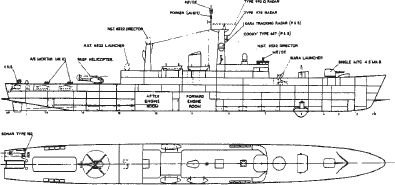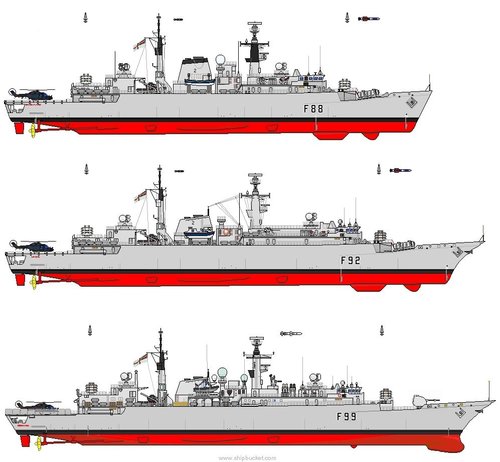I'm not sure having three Audacious makes much positive difference.
Hermes is unlikely to complete to the standard that she did as there would be no need to try and shoehorn Buccaneer onto her.
Manpower post 1967 becomes an issue, also Healey's post 1966 removal from EoS means the RN doesn't really need 3 carriers as the bases east of Gib slowly close down. One of them is bound to get the chop, in RL it was Victorious after her fire gave a convenient excuse.
Even is you get past, the 1973-74 Defence Review has its own axes to wield.
CVA-01 and CVA-02 are killed outright. With CVA dead the innovative Direct-Acting (Water Spray) Arrester Gear (DAAG) is likely dead too. So that removes the ability to grow future aircraft weights beyond 40,000lb at 125kt (the Mk.14 fitted to Ark Royal, older Mk.13 was 30,000lb). DAAG was the same rating but of course had more growth being a new design whereas Mk.14 was a super-beefed up Mk.13).
So its more than likely that the FAA keeps on with Phantom and Bucc until the 1990s. With Skyflash and Sea Eagle that's no bad thing.
Means the RAF post-TSR fiasco is worse unless they pony up for more new-build Buccs and of course no extra Phantoms to boost the air-defence squadrons.
Would the Thatcher government fund replacements? Who knows, its a 50/50 gamble, they might but on the other hand Nott might just stick with a 2 or 3 CVS and would probably sell one of the surplus Audaciouses to the Argies to boot!
With one exception I fear that you are right.
The exception is Hermes. I think she'll still be completed to Standard A-Star in 1959 but she may not have the 1964-66 refit that the reference books say enabled her to operate the Buccaneer.
According to Friedman in British Carrier Aviation Hermes was completed with a pair of 151ft stroke BS.4 steam catapults, which were the same length as the BS.4s that Ark Royal was completed with. However, @Riain on Alternatehistory.com (the site's resident aircraft carrier catapult expert) says Hermes was completed with a pair of BS.4s with strokes of 103ft and one of them was lengthened 151ft to allow it to launch Buccaneers as part of its 1964-66 refit. I disagree with him because the BS.4s fitted to Centaur in its 1956-58 refit had a stroke of 139 feet and as far as I know the deck edge lift that Hermes was completed with meant that there was space in the bow for longer catapults. @Riain replied that the photographic evidence proves that one of her catapults was lengthened, which indeed it does. However, my argument was that while that is obviously true one of the catapults had been lengthened it was increased from 151ft not to 151ft. I tried to work out the lengths of the catapults of all the Royal Navy's aircraft carriers by measuring the line drawings in contemporary editions of Jane's Fighting Ships, but the results were inconclusive because I wasn't sure how accurate the line drawings were and whether I was measuring the total length of the catapult or the "stroke".
If the third Audacious isn't cancelled in 1946 there are two possible timelines.
The first timeline is that construction of the ship continues at the same rate as Ark Royal and Eagle. She's launched around 1950 and at that time completion would be planned for about 1952. However, in common with Ark Royal its decided to complete the ship with an interim angled flight deck and a pair of 151ft stroke BS.4 steam catapults. According to Leo Marriott in Royal Navy Aircraft Carriers 1945-1990 most of the delay was caused by fitting the steam catapults.
The second timeline is that (in common with Hermes) the ship is suspended in 1946 and resumed in 1952. This allows the ship to be completed in the late 1950s to Standard A rather than Standard C. This means that the ship is completed with a fully angled flight deck, one Type 984 radar, a 48-track Comprehensive Display System (CDS) and the Direct Plot Transmission (DPT) data link. She'd also have an AC electrical system rather than the DC systems that Ark Royal and Eagle had. In the real world the Admiralty wanted to replace Eagle's existing armour with new armour that was thinner and lighter during her 1959-64 refit, but it had to be deleted to reduce the cost of the refit. It might be possible to complete the third Audacious with this armour scheme. She might also be completed with the same type of twin 3" gun mountings that were fitted to the rebuilt Victorious rather than the twin 4.5" guns that her sisters were completed with.
I want to say that the second timeline version of the ship would be completed with a pair of BS.5 steam catapults. That is one with a stroke of 151ft in the bow and a one with a stroke of 199ft in the waist. That is the same as Eagle after her 1959-64 refit and Ark Royal after her 1967-70 refit. However, I think that she'd be completed with a pair of 151ft BS.4s in the bow.
I'm not sorry to disappoint the Victorious haters because she still has her "great rebuild" of 1950-58 in both of the above versions of history. The difference is that Centaur is paid off in 1960 instead of 1965 and the third Audacious takes her place in the first half of the 1960s. This allows Albion's conversion to a commando carrier to begin in 1958 instead of 1960 - according to Friedman in British Carrier Aviation her conversion had to be delayed to maintain a force of 5 strike carriers.
So to cut a long story short the strike carrier force in the first half of the 1960s is 5 ships consisting of Ark Royal, Eagle, Hermes, Victorious and the third Audacious rather than 5 ships consisting of Ark Royal, Centaur, Eagle, Hermes and Victorious.




